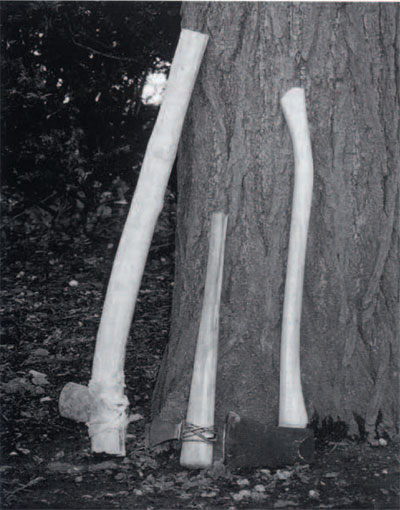
The plunging of a silver shovel into the dirt on April 14, 2000, marked the official groundbreaking for the construction of the Museum’s Mainwaring Wing. But the wielding of a bronze axe a month earlier marked an unofficial start of sorts. A line of gingko trees that stood in the way of the new wing had to come down before construction began and, in an attempt to salvage something educationally useful from their removal, a demonstration of experimental archaeology was undertaken. And so it was that, on March 13, various students, faculty, and Museum staff gathered to witness and test the effectiveness of 3500-year-old bronze technology by using replica axes to fell two trees.
Years ago as a Penn undergraduate, I had learned about experimental research and executed a tree-felling experiment with my colleague Daniel Meyer. Now, as an instructor of my own course, I was teaching undergraduates about the role of experimentation in archaeological interpretation.
Thanks to the construction of the new wing, I was able to offer my students a little “hands-on” experience with ancient tools. Experimental archaeology uses a variety of methods and techniques to replicate or simulate aspects of the past in a controlled manner in order to generate and test theories about the past. Most typically, this involves the use of ancient tools or materials (or replicas of these) in a traditional manner, thereby allowing us to understand early peoples’ practices and capabilities. For example. cutting down a tree with a stone axe not only provides us with a better understanding of how such axes were hafted and used, but also gives us a sense of the effort required to fell a tree with stone technology. From there, theories about how many people and how much time were needed to clear land for farming or to supply timber for buildings can be developed, leading to better understandings of past social organization.
The particular experiment that Dan and I undertook in 1991 involved the felling of too trees (which had been designated for removal) on his parents’ property in Vermont. Our major objective was to test the theory of technological progress implied by the archaeologically observed transition in Europe from the Stone Age/Neolithic (pre-2000 BC) to the Bronze Age (2000-800 BC) and finally to the Iron Age (from 800 BC). We decided to do this by comparing the relative effectiveness of stone, bronze, and steel axes for cutting down trees.
We cut down the trees using real Neolithic stone axes obtained from the Museum’s collections with the permission of the Destructive Testing Committee, replica bronze axes made especially for the study, and modern steel hatchets and axes. By balancing our experimental design carefully. we were able to control for a number of variables and isolate their importance. These included the type, hardness, and size (diameter) of the tree, the length of the axe handle and its blade, and to some extent, other environmental variables such as uneven slopes and dense vegetation.
As one might expect, we found that the process went markedly faster using metal axes than with the stone axes, particularly when cutting larger trees. This corroborated the previous experimental literature on the topic. However, to our surprise we were also able to clearly show that bronze axes were just as good as steel ones for felling trees, suggesting that no great benefit in effectiveness could have prompted early peoples to switch from bronze to iron axes. As a result, we argued that a simple theory of technological progress could not fully explain the bronze-toiron transition and probably was even insufficient for explaining other technological transitions. In other words, there were probably always a variety of economic, social, political, and even ideological issues that came into play and helped effect (or inhibit) technological change.

Furthermore, beyond these “scientific” results, the experiment also provided us with a broader perspective on the past by actually simulating past behavior. Our “hands-on” experience with the axes and tree-felling made us appreciate the variety of situations early peoples might have faced and their possible responses. This is particularly important when considering the most common critique of our experiments, i.e., “But you’re not strong Neolithic farmers who would have been accustomed to this work!”
In addressing this, I wholeheartedly agree but would like to point out that this misses the point. There is no “normal” or “standard” past out there to be discovered. Instead, we need to appreciate the variability of past peoples and their lives. Rather than thinking that all ancient tree fellers were brawny men, we need to consider that at least some were women, that many would have been young and inexperienced (at least initially), and that others would have been (eventually) old or unhealthy. By choosing a relatively diverse group of people to wield a bronze axe on March 13, I tried to stress this point. To truly appreciate the past, we need to consider these other perspectives and a good way to do this is via experimental archaeology.
James R. Mathieu
Ph.D. candidate, Dept. of Anthropology, University of Pennsylvania
ACKNOWLEDGMENTS
I would like to thank the following people for making the tree-felling demonstration possible: Dr. Jeremy Sabloff, Brenda Loewen, Pam Kosty, Dr. Bernard Wailes, Chrisso Boulis, and the graduate student tree-fellers, Greg Borgstede, Michael Danti, and Melissa Vogel.
